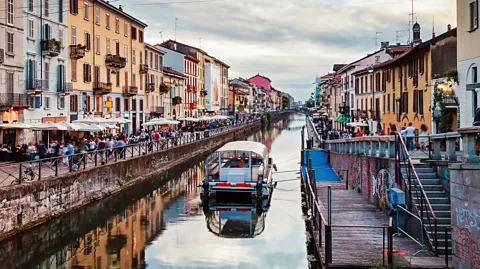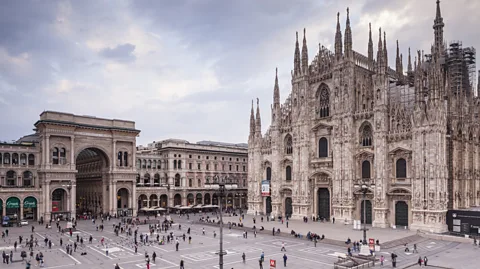Milan: Italy’s lost city of canals
 Gennaro Leonardi/Getty Images
Gennaro Leonardi/Getty ImagesAlthough not widely known, Milan’s centre was once traced with waterways, not unlike those of Venice or Amsterdam.
Just before Italy’s second lockdown in November 2020, the banks of Milan's Grand Canal were busy with people. Bargain hunters picked their way through market stalls, browsing tables of retro telephones, haphazard rows of art deco furniture and racks of vintage clothing. Others sat in the cafes, sipping aperitivi or coffee, gazing out at the shoppers. The clear water of the canal reflected the dazzling autumn sunshine.
This is a familiar scene in Milan’s Navigli district on the last Sunday of every month, when the city’s 400-stall antiques market takes over. In this bohemian chunk of Italy’s financial capital, the austere blocks of the city centre make way for pastel-coloured houses, cobblestone canal pathways and bridges. I strolled among the mask-clad shoppers, trying to eke out some normality amid Milan at its most casual.
Located in the city's south-west corner, the Navigli district remains one of the last true connections the Milanese have with water. The Grand Canal (Naviglio Grande) itself dates back to 1177, making it one of the oldest navigable canals in Europe. Today, it’s packed with bars, cafes, restaurants, art galleries and boutiques; in non-lockdown times, it's a lively meeting spot or a place for a gentle eggiata stroll by the water.
 Julian Elliott Photography/Getty Images
Julian Elliott Photography/Getty ImagesYet this small corner of the city has a much bigger history; although not widely known, Milan’s centre was once traced with waterways, not unlike those of Venice or Amsterdam.
Think of almost any major inland city and there’s a big river to go with it. London has the Thames. Paris, the Seine. Berlin was built around the banks of the Spree. Yet, Milan, one of the wealthiest cities in Europe, has none. So, the city had to make one for itself. Between the 12th and 17th Centuries, a network of navigli (canals) was developed in order to grow the landlocked city’s wealth and influence. By the end of the 15th Century, Milan’s canal system connected the city to the River Ticino (25km to the west) and the River Adda (35km to the east). At the network’s heart, the Cerchia Interna (The Inner Ring) and a series of smaller channels knitted the whole thing up.
You may also be interested in:
• Could this city be the new Rome?
Most of the last traces of this network can be seen in Navigli, and in the north of the city, at the Martesana canal. The rest fell victim to modernisation during the mid-20th Century; as automobiles and trains replaced boats as the fastest modes of transport, The Inner Ring was buried under concrete. For the most part, the canals are still there, covered over by new roads and buildings. Some vestiges still remain in the city centre, such as the Incoronata Lock at the end of Via San Marco. Today, the lock is a curious sight: two sets of large wooden gates, frozen slightly open, useless without water, in the middle of Milan.
 Gennaro Leonardi/Getty Images
Gennaro Leonardi/Getty ImagesWhen I first visited Milan in 2013, I was instantly struck by Navigli. Back then, I being charmed by the slow-paced waterside lifestyle, far removed from the frenetic city centre. Unlike Italy’s other great cities, there is no ancient Centro Storico district in Milan, but Navigli felt like a different sort of old town. It wasn’t until I returned last year, this time to live, that I realised the significance of the canals and saw the growing movement to re-open the rest of these historical channels. There was a new energy around Navigli, and it was flowing from the Darsena.
The Darsena (meaning "dock" or "shipyard") sits at the meeting point of two of Milan’s last canals, Naviglio Grande and Naviglio Pavese. Once one of the busiest ports in Italy until it was decommissioned during the rapid urbanisation of the 1960s, this harbourside area was nothing more than overgrown swamp on my initial visit. It lay largely unused until 2015, when it was completely renovated for the Milan Expo. Now, in place of bare concrete and overgrown weeds, a thriving urban lagoon, surrounded by cafes, bars, local businesses and a market hall, fills its formerly unloved space.
At first, however, the Milanese were sceptical of the dock’s re-opening, according to Mirta Oregna, a rower from Canottieri San Cristoforo, a local club on the Naviglio Grande. “In the beginning there was a lot of 'why are they doing this">window._taboola = window._taboola || []; _taboola.push({ mode: 'alternating-thumbnails-a', container: 'taboola-below-article', placement: 'Below Article', target_type: 'mix' });
